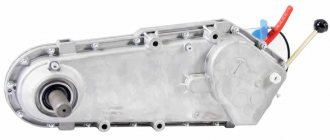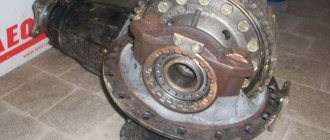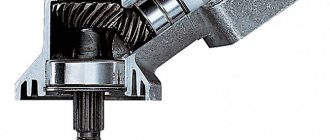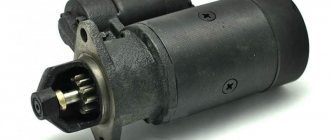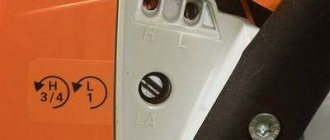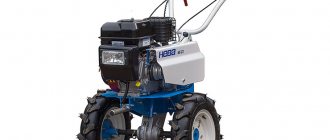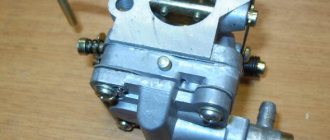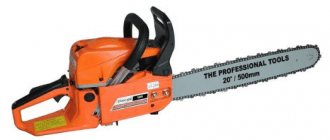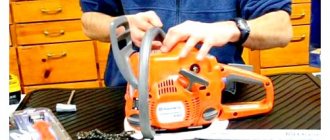.. 30 31 32 33 34 35 36 37 38 39 40 ..
Disassembly and assembly of the gearbox of walk-behind tractors Oka, Neva, Cascade (MB-1)
Disassembly and assembly of the MB-1 gearbox
The gearbox of the MB-1 walk-behind tractor is the basis on which other components and assemblies of the walk-behind tractor are mounted. Therefore, to repair the gearbox with disassembly, it is necessary to disassemble the walk-behind tractor, for which you need to dismantle the engine, steering column, pan, brackets with forward and reverse belt pulleys, gear pulley, wheels. Before disassembling the gearbox, clean it from dirt and drain the oil. Remove the rotating head from the gear shift knob by knocking out the pin holding it with a thin drift. Unscrew the locking screw 11 (Fig. 36) and remove the bushing 9 and the retaining spring 10 from the shift shaft 7. Unscrew bolts 17 (Fig. 35) securing the housing halves, then tightening bolts 7 (2 pcs.) and 10. Place the gearbox on the left half of the housing, using a thin screwdriver or knife, carefully so as not to damage the gasket, undock the gearbox halves and remove the right half. Leave the spacer washers for the tie bolts on the block sprockets. Note. It is recommended to remove only defective parts from the gearbox, without completely disassembling the gearbox. To disassemble the gear shift mechanism, remove retaining ring b from shift shaft 7 (Fig. 36), ensuring free movement of sprockets 31. 32 (Fig. 35). Remove the cotter pin 3 (Fig. 36) from the threaded part of the shift handle 1, unscrew it (counterclockwise) from the block 8 and remove the handle and the block from the shaft. Wash removed parts and replace defective parts. Replace the shift shaft seals after removing it from the gearbox. Reassemble the gearbox in reverse order. Apply a thin layer of sealant to the mating surfaces of the body halves. Start connecting the halves of the housing with the central tightening bolts 7 and 10 (Fig. 35), then the bolts for fastening the halves, starting from the middle part of the gearbox with a sequential transition of tightening the bolts to the edges. Before final tightening of the bolts, check the smooth running of the moving parts of the gearbox.
Gearbox diagram of walk-behind tractor MB 1
Design of the gearbox for walk-behind tractors Oka, Neva, Cascade (MB-1)
Design of the gearbox for walk-behind tractor MB-1
The gearboxes of the MB-1 “Neva” (previously produced), MB-1D “Oka”, MB-1 “Cascade” walk-behind tractors (except for its individual modifications) have the same design, shown in Fig. 35.
The gearbox housing is steel, stamped, consists of two halves 2 and 22, fastened together through a sealing gasket with 3 bolts. Angles 8 and 23 are welded to each half of the body, forming the supporting frame of the walk-behind tractor.
Rice. 35. Gearbox with walk-behind tractor MB-1 (longitudinal section): 1 — shift handle; 2 — right half of the body; 3 - gasket; 4 — chain (34 links); 5 - plug; 6 - finger; 7 - bolt; 8 — right square; 9 — second sprocket block; 10 - bolt; 11 - finger; 12 — chain (30 links); 13 — third block of sprockets; 14 - finger; 15 — bearing; 16 — output shaft; 17 — M6 bolt; 18 - cover; 19 — cuff; 20 — bearing; 21 — chain (28 links); 22 — half of the body, left; 23 — left square; 24 — chain (36 links); 25 — first block of sprockets; 26 — chain (46 links); 27 — shift shaft (input shaft); 28 — cuff; 29 — bearing; 30 - bearing; 31 — sprocket (first gear); 32 — sprocket (second gear).
The internal structure of the gearbox is shown in Fig. 36-40.
Rice. 36. Shift shaft: 1 — shift knob; 2 — sealing ring; 3 - cotter pin; 4 — asterisk; 5 — washer: 6 — ring; 7 — shift shaft; 8 — switching block; 9 — bushing; 10 — clamp spring; 11 — locking screw
Rice. 37. First block of asterisks: 1 - first block of asterisks; 2 — washer; 3 — bearing 942/15: 4 — bushing; 5 - finger
Rice. 38. Second sprocket block: 1 - second sprocket block; 2 - bushing; 3 — bearing 941/20; 4 - finger; 5 - washer
Rice. 39. Third block of asterisks: 1 - third block of asterisks; 2 - bushing; 3 — bearing 941/20; 4 - finger; 5 - washer
Rice. 40. Output shaft: 1 - washer; 2 — output shaft; 3 - bushing
The torque from the input shaft 21 (Fig. 35) to the output shaft 16 of the gearbox is transmitted either from the left 31 or from the right 32 sprocket of the input shaft. One or another sprocket is brought into engagement with the input shaft using a block 8 (Fig. 36), moved along the axis of the shaft by shift handle 1. When handle 1 is recessed, sprocket 31 is engaged and first (low) gear is engaged. When handle 1 is extended all the way, the second (highest) gear is engaged.
The middle position of shift knob 1 is neutral.
Gearboxes of MB-1R “Neva” walk-behind tractors. MB-1 “Cascade” models 6841-01, 6841-03, 6841-05 and 69412,69412-07 differ in the design of the output shaft installation. In these gearboxes, the output shaft is installed on ball bearings instead of needle ones; accordingly, the type of cuffs and the design of the covers that cover them have been changed.
Rating of TOP 10 best models
| Place | Name | Price |
| TOP 5 best light Russian walk-behind tractors | ||
| 1 | Neva MB-1B-6.5 | 39 000 ₽ |
| 2 | Neva MB-1B-6.0FS | 46 000 ₽ |
| 3 | AGAT X5 | 36 000 ₽ |
| 4 | Neva MB-B6, 5 RS | 36 000 ₽ |
| 5 | Neva MB1B MA(RS950) | 39 000 ₽ |
| TOP 5 best medium-sized Russian walk-behind tractors | ||
| 1 | Tselina NMB-901 | 35 000 ₽ |
| 2 | Neva MB-2KS-(168FA) | 36 000 ₽ |
| 3 | Neva MB-23B-10.0 | 54 000 ₽ |
| 4 | Neva MB-23-Y (MX300) with MultiAgro gearbox | 65 000 ₽ |
| 5 | AGATE L-6.5 | 29 000 ₽ |
Description of the MB-1 walk-behind tractor
Motoblocks MB-1 are very popular in our country. They began to be produced in the 80s and are constantly being improved. Their towing class is 0.1, with additional and trailed equipment. This figure indicates the traction force of the vehicle.
If we consider that walk-behind tractors and mini-tractors are divided into 7 classes, then this unit is in the first row.
Attachments allow the motorized cultivator to plow the soil, hill it, loosen it, dig up root crops and rake grass. A trailer is used to transport various loads. The optimal cultivated area is 6-40 acres.
After purchasing the MB-1 unit, you need to carefully study all the recommendations presented, which are contained in the operating manual.
For the MB-1 cultivator, the characteristics are as follows:
- The main part on which all units are mounted is the cylinder block.
- An internal combustion engine is a gas distribution mechanism that controls gas flows. This mechanism consists of a camshaft and adjacent components (exhaust and intake valves).
- The camshaft diameter is 30 mm, length is 280 mm.
- The crank mechanism, the crank mechanism, ensures the rotational movement of the piston.
- Fuel system - supplies and filters fuel from the tank and delivers it to the cylinders.
- There is an ignition system to produce an electric spark.
- A starting device that assists in starting the engine.
- Cooling system that prevents engine overheating.
One of the manufacturers of the MB-1 Oka walk-behind tractor is located in Kaluga. It produces three variants of walk-behind tractors: A, B and C:
- Option A. Motoblock MB-1D1M 10.
- Option B. Motoblock MB-1D2M.
- Option B. Motoblock MB-1D3M.
Each of them has different engines:
- MB-1D1(2, 3) M - DM 1M engine, power 8.0/5.9 (hp/kW);
- MB-1D1(2, 3) M 1 - DM 1M engine, power 8.0/5.9 (hp/kW);
- MB-1D1(2, 3) M 1 - Mitsubishi GT600 engine, power 6.0/4.4;
- MB-1DK (2, 3) M 7 - I/C 6.0 HP engine, power 6.0/4.4;
- MB-1D1(2, 3) M 9 - engine NONDA GX - 200, power 6.5/4.8;
- MB-1D1(2, 3) M 10 - Lifan 168 F-2A engine, power 6.5/4.8;
- MB-1D1(2, 3) M 10 - Lifan 168 F-2A engine, power 6.5/4.8;
- MB-1D1(2, 3) M 11 - Vanguard 6.5 HP engine, power 6.5/4.8;
- MB-1D1(2, 3) M 12 - Lianlong 168F 1A engine, power 6.5/4.8;
- MB-1DK (2, 3) M 13 - Robin Subaru EX 17 engine, power 6.0/4.4;
- MB-1DK(2, 3) M 14 - Robin Subaru EX 21 engine, power 7.0/5.2;
- MB-1D1(2, 3) M 15 - KADVI 168F - 2A engine, power 6.5/4.8.
When working with the MB-1 motor-cultivator, the operating instructions will help the farmer understand the main aspects of the unit’s operation.
There is another walk-behind tractor from a Chinese manufacturer, which is approved by our GOST. This is an MB-2 m walk-behind tractor. The engine power of the walk-behind tractor is 6.5 hp. It copes well with the ground and at the same time consumes little gasoline. In user reviews regarding the Chinese model, there are dissatisfaction with parts that are made not of metal, but of plastic. During intensive work there is one minus: the cutters often break and the starter cord breaks.
Forza walk-behind tractors from , which produces advanced equipment, as well as spare parts and attachments, are also popular. The basic model is the FZ-01-6.5F cultivator. They have a modern design, they are quite reliable and durable.
Engine
Robin Subaru EX 21 engine Mitsubishi engine, 6 hp Lianlong LL-160F engine Honda GX270 engine
Depending on the modification, the Oka walk-behind tractor is equipped with engines from different manufacturers (DM-1M, DM-1M1, MITSUBISHI GT600 6.0/4.4 , I/C 6.0 HP 6.0/4.4, Honda GX-200 6.5/4.8, Lifan 168 F-2A 6.5/4.8, Vanguard 6.5 HP 6.5/ 4.8, Lianlong 168F-1A 6.5/4.8, Robin Subaru EX 17 6.0/4.4, Robin Subaru EX21 7.0/5.2, KADVI 168F-2A).
Engine Lifan LF177
One of the popular modifications is the Oka with the Lifan engine. This engine is economical, and its functionality allows it to be installed in small-sized equipment (motor cultivators, walk-behind tractors). Lifan is manufactured in China and has proven itself to be a durable and reliable engine.
The choice of model is made depending on the area of land the operator intends to cultivate using the walk-behind tractor, as well as on the main tasks (plowing, cultivation, digging up potatoes, etc.) that the device will perform.
Engine malfunctions
Let's figure out why the engine on the Oka walk-behind tractor may be acting up? So, the main reasons that the engine does not work and the walk-behind tractor does not start may be the following:
- insufficient fuel or oil level;
- low-quality gasoline;
- clogged fuel or oil filter;
- problem with spark plugs or seals (oil is leaking; spark plugs need to be replaced);
- the angle of inclination when setting up the walk-behind tractor is exceeded (more than 15 degrees, start the walk-behind tractor on a flat surface);
- the integrity of the electrical wiring is compromised;
- rupture or delamination of transmission belts;
- poor tire pressure in combination with any of the above reasons;
- attempt to start the engine without warming up;
- The storage temperature of the walk-behind tractor is too low, as well as a big minus outside when starting the equipment (store the walk-behind tractor in a warm room; in sub-zero temperatures, pour warm oil into the engine and gearbox).
Carburetor of MB-1 walk-behind tractor
Let's look at the carburetor of the MB-1 walk-behind tractor. The device regulates the fuel supply to the engine and prepares the combustible mixture (mixing fuel with air). It is part of an internal combustion engine.
Why do you need to adjust the carburetor? A situation may arise when the walk-behind tractor begins to work unstably. This can happen if the unit has not been used for a long time or, on the contrary, has undergone heavy loads. In such a situation, you will need to adjust the carburetor, for which there are special instructions.
The carburetor must be adjusted in the following sequence:
- Tighten the full and low throttle screws all the way (without overdoing it), and then unscrew them one and a half turns.
- Start the engine and wait 10 minutes for it to warm up.
- Without turning off the engine, set the lever to minimum speed.
- Using the screw (throttle valve), which regulates the amount of fuel flowing, you need to achieve such a minimum idle speed at which the interruptions will stop.
- Adjust the throttle screw to maximum and then to minimum. This must be done until the motor starts working normally.
- Move the engine lever to gas.
- Set the throttle screw to a maximum of 2.5 turns.
Installing and replacing belts
| Belt sizes for the Oka walk-behind tractor and modifications | |
| Drive belt for forward movement: | A-1180 vn I GOST 1284.1-89; A-1213 I GOST 1284.2-89. |
| Drive belt for reverse gear: | Z(0) 1400 I or Z(0) 1400 int I GOST 1284.1-89. |
The belts are removed manually by loosening the adjusting bolt. Belts are replaced with similar ones that are suitable in width and length. It is advisable to purchase spare parts, incl. and belts, in stores of branded spare parts for walk-behind tractors. Such stores work directly with manufacturers.
Video review of replacing walk-behind tractor belts:
How do you know whether to tighten the belt?
If you press down on the belt with your hand, it should only flex slightly when pressed. If they sag, the engine will hum, and blue smoke may even appear from overheating. Worn belts recessed into the belt cells need to be replaced. First, remove the nuts holding the belt frame together. Next, use the adjusting bolt to tighten the belts, periodically checking the tension manually.
The same manipulations are carried out after installing new belts in order to regulate them.
MB-1 cultivator gearbox design
Let's look at the design of the gearbox of the MB-1 walk-behind tractor. This is a device responsible for rotation, movement from the engine to the wheels. The MB-1 walk-behind tractor gearbox is assembled in such a way that on its outer side there are elements responsible for changing gears. The gearbox has five positions. When pressed, the fork disengages the clutch. When reset, it returns to its original position.
When the drive is connected to the right side, the unit will stop. The rotation comes from the sprocket. When the handle catches the left sprocket, the gear is reduced. If maximum gear is desired, the handle is pulled out all the way.
Assembly and adjustment of the gearbox is carried out after repair or malfunction. Before the procedure, each part is inspected for damage and contamination.
Sometimes the engine on the MB-1 walk-behind tractor is replaced. This is done if you want to install an imported engine on a domestic model. For this purpose, a kit is used, which includes a plate (platform, pulley), belt transmission, and a set of fasteners. There is an engine replacement diagram. Thanks to the drawings, it will be possible to easily cope with the replacement.
Old-style motor cultivators are also popular. The first Soviet walk-behind tractor, MB-1, is a very durable and reliable technique that was used for various purposes. They were produced on the basis of Soviet cultivators, which were quite durable.
How to do it?
Enthusiastic craftsmen assure that a simple gearbox for a walk-behind tractor can be straightened with your own hands in a home workshop. To do this, you need to have a certain set of tools and more or less skills in working with them.
You will need:
- ruler and caliper;
- a set of different screwdrivers;
- hacksaw;
- pliers and wire cutters;
- vice;
- hammer;
- welding machine if necessary;
- spare parts and consumables (oil seal, rubber gasket, bolts, gears, chain or belt, bearing, shafts).
Of course, sketches are needed for construction. Therefore, if you lack the skills to build them yourself, you can turn to ready-made ones from the Internet or specialized magazines.
If the converter is created on the basis of an existing old one, then first you should disassemble it, remove unnecessary parts and modify it.
By the way, gears and shafts can be removed from an old chainsaw.
Next, you need to calculate the gear ratio. It is necessary to select the number of gears and the length of the shafts. Usually they take the number of idle revolutions of the crankshaft as a basis and add 10 percent to it.
A simple homemade gearbox uses two opposing shafts. On one side there is a gear in which a hole needs to be drilled, on the other there is a shaft complete with a race and bearings. Next, the output shaft is mounted on the pulley. In this case, you must remember to insulate the shafts with oil seals so that the oil does not leak.
The assembled structure is inserted into the housing, into which lubricant or oil is poured. The converter is connected to the motor. Then the setting is carried out, for which the mechanism is launched.
The device does not need to be overloaded during testing; the components must break in and establish mutual action. Only after checking and eliminating all defects can the gearbox be used for work.
To learn how to make a gearbox for a walk-behind tractor with your own hands, see the following video.
Description
This article will discuss the design, repair and maintenance of the OKA walk-behind tractor. Since 1991, this motorized device has been produced at the Kaluga Motor Plant under the name Motoblock MB-1.
Starting in 2011, the unit was renamed “Oka”. Its purpose is to carry out all types of agricultural work on small and medium-sized plots of land with different types of soil. Functional attachments, presented in the assortment by the manufacturer KaDvi, significantly expand the capabilities of the walk-behind tractor.
Motoblock Oka - operating instructions
When purchasing any Oka model, the first thing you need to do is read the operating instructions for the motorized device, which contains the following sections:
- The design of the unit (as well as the design of its components: gearbox, carburetor, etc.).
- Assembling the Oka walk-behind tractor, according to descriptions and diagrams.
- Technical characteristics of the selected model.
- Instructions for starting the engine for the first time (Lifan, Honda or any other).
- The procedure for proper running-in of the power plant.
- Maintenance.
- Troubleshooting the Oka walk-behind tractor.
see also
Comments 23
Have you changed the seals on the gearbox?
Changed both lower and upper
Could you please share the order numbers? I can send you a private message, the lower one has been leaking for a long time, I keep adding more, but I can’t get around to it
I'll post it a little later
Could you please share the order numbers? I can send you a private message, the lower one has been leaking for a long time, I keep adding more, but I can’t get around to it
I'm crazy - there is a needle bearing in the gearbox - now in the second Neva there are only ball bearings.
Well, in those days they were on pins and needles.
I'm crazy - there is a needle bearing in the gearbox - now in the second Neva there are only ball bearings.
If you have come across the VOSKHOD motorcycle, then there are the same ones on the connecting rod. They probably rang like crazy from the factory. As this unit was used, these needles turned into the shape of matches. Well, they're just as square. I remember and laugh...
but here it’s power crap - needles are the best solution for a gearbox - the vertical load on the shaft is distributed over a large area of the bearing, that’s what I’m getting at. Apparently in the USSR they didn’t think about cheapness but thought about the design - if you pour normal oil into the gearbox, and not eight mineral water, then such a bearing will last a long time. I also thought that it would be easier to buy an old walk-behind tractor with a dead engine and put a new Chinese engine on it.
Well, as an option. Although if they now exist (needle-shaped) in a modern design, I think the same crap as ball-type ones. Where can I find it, that old walk-behind tractor? Well, if only suddenly oh how very lucky.
but here it’s power crap - needles are the best solution for a gearbox - the vertical load on the shaft is distributed over a large area of the bearing, that’s what I’m getting at. Apparently in the USSR they didn’t think about cheapness but thought about the design - if you pour normal oil into the gearbox, and not eight mineral water, then such a bearing will last a long time. I also thought that it would be easier to buy an old walk-behind tractor with a dead engine and put a new Chinese engine on it.
there the entire assembly (all the shafts) is on needles, as they wrote above, the needles are good and I agree with this, but they are also more capricious, they have a couple of disadvantages, but I did not convert them to balls, as many are doing now)
Motoblock device
All existing Oka walk-behind tractors have the following device:
- Gas engine;
- rigid frame;
- adjustable steering bars with rubberized handles;
- transmission (reinforced chain reducer, V-belt transmission, mechanical gearbox, clutch, PTO drive);
- chassis (wheel drive);
- gas tank;
- filters (oil and air);
- ignition system;
- inertial starter.
The kit may include tillers and a hitch.
Depending on the modification, Oka walk-behind tractors can be equipped with various engines:
- The Oka MB-1D1(2, 3)M9 walk-behind tractor is equipped with a Honda carburetor engine (HONDA GX-200) with a capacity of 6.5 horsepower.
- Models MB-1D1 (2, 3)M10 have a Lifan gasoline power unit (Lifan168 F-2A) with a capacity of 6.5 liters. With.
- The MB-1D1 (2, 3) M15 walk-behind tractor was equipped with the original factory KADVI 168F-2A 6.5 liter engine. With.
- Modifications MB-1D1 (2, 3) M13 and M14 received a Robin Subaru EX17 or EX21 power plant, with a capacity of 6.0 and 7.0 liters. With. respectively.
- Models MB-1D1 (2, 3)M and MB-1D1 (2, 3)M1 are equipped with DM-1M and DM-1M1 engines with a power of 8 hp. With.
Common to all listed power plants:
- one cylinder;
- cycle for 4 cycles;
- forced air cooling;
- use of AI-92 or AI-95 gasoline.
The ignition system is electronic, which includes: magneto, spark plugs, high-voltage wire.
It is necessary to start the engine correctly, according to the algorithm specified in the instructions. If certain actions are not followed, there is a high risk of engine failure. We invite you to watch a short video on how to start the Oka walk-behind tractor:
Gearbox device
The walk-behind gearbox transmits torque from the engine to the wheel drive. Its design is as follows:
We suggest studying the cross-sectional diagram of the Oka walk-behind tractor gearbox:
What type of gearbox can be installed on the Oka walk-behind tractor?
It is best to use a collapsible chain gearbox, which consists of a collapsible housing with bolted connections. Unlike a non-separable gearbox, such a mechanism can be easily repaired and will last for many years. A gear reducer can be installed on more powerful equipment; a worm gearbox is rarely practiced in walk-behind tractors.
The design and principle of operation of the carburetor
Carburetors are gas distribution devices inherent in gasoline engines. The function of the carburetor is as follows:
- regulates the amount of incoming gasoline and air;
- saturates the air with gasoline vapors.
We suggest that you familiarize yourself with the carburetor diagram for the Oka:
Varieties
The manufacturer of the domestic brand "Cascade" produces several models of walk-behind tractors on the market, which differ in design.
Types of units.
- Angular - provides connection between the power plant and transmission. Most often used by farmers for farming. The features of this type include the ability to complement, improve, increase productivity, and reduce labor costs.
- Reducing - in this case, the mechanism increases the engine load and also reduces the number of revolutions during operation. According to reviews from owners of the gearbox, it is distinguished by its reliability, versatility, due to the use of durable material in the manufacture of each part, as well as being equipped with a high-quality cooling system. Another advantage of the step-down type is high performance under any load conditions.
- Reverse gearbox is a mechanism with a reverse function, which is mounted on the main shaft. True, it has two disadvantages - low speed, poor performance.
- Gear – designed for large size models. Despite the simple design, the robust, reliable body is quite difficult to maintain.
- Worm - the main parts include a special screw and a toothed worm wheel. Each spare part is made from durable material, which allows us to call this type of gearbox the most reliable. Among the advantages, the manufacturer highlights a reduced angular velocity and a higher type of torque. In operation, the gearbox does not create much noise and operates smoothly.
Maintenance of Oka
Maintenance of a walk-behind tractor includes several stages:
- Daily work before and after use.
- Change of oil.
- Scheduled inspection.
- Preservation for long-term storage.
Let's consider the first point.
Before operating the Oka walk-behind tractor, you must:
- check the oil and fuel levels; only fill in high-quality working fluids;
- check the reliability of bolted connections;
- check tire pressure.
After use you must:
- thoroughly clean and wash the walk-behind tractor;
- dry in the shade;
- lubricate all components and mechanisms;
- put into storage.
No less important is the second point - “Oil change”. The first replacement is made after running in the walk-behind tractor. After every 25 operating hours, the oil level in the gearbox is checked and fluid is added if necessary. The transmission oil is changed every 50 operating hours.
Routine inspections must be carried out after the first 100, 200 and 500 engine hours; it is recommended to completely change the oils, both in the engine crankcase, gearbox, and transmission.
It is recommended to fill the engine of the Oka walk-behind tractor with the following motor oils:
We invite you to watch a short video showing how to change the oil in the gearbox of an Oka walk-behind tractor:
Malfunctions
The instructions included with the Oka walk-behind tractor contain a table that lists all possible problems, but we will focus on the most common ones:
Why the Oka walk-behind tractor does not start:
- the tank has run out of fuel;
- the oil level in the crankcase is below normal;
- the ignition system of the Oka walk-behind tractor requires adjustment or has failed;
- carburetor adjustment required;
- filters are clogged and require replacement;
- spark plugs are burnt out, smoked or wet;
- the seals have failed.
The wheels (cutters) have stopped rotating:
- the clutch cable is loose;
- it is necessary to change stretched or torn belts, this will help restore the functionality of the Oka walk-behind tractor.
The gearbox is leaking:
- the cause may be worn out cuffs of the axle shafts; they need to be replaced with new ones;
- The seals require replacement.
Extraneous noises are coming from the gearbox:
- the bearing is incorrectly installed or broken;
- broken sprockets;
- broken chain.
MB-1 walk-behind tractor: operating instructions and do-it-yourself fault repair
Special equipment, such as a walk-behind tractor, is very useful in farming. Due to the fact that walk-behind tractors are maximally balanced in terms of price, cost and performance ratio, they benefit greatly from both tractors and other special equipment.
With its help, you can perform a large number of different operations that take a lot of time and require a lot of effort, using manpower and simple equipment. All areas where a walk-behind tractor can be used no longer evoke disgust and reluctance to work.
In fact, all the work comes down to management - you just need to be present as a driver.
This applies to both modern technology and older models of walk-behind tractors, because over the decades their design, in general, has changed little - weight has decreased, the variety of models has increased, and more advanced materials are used for manufacturing.
But the frame, engine placement and control method remained the same , the attachments, in fact, remained unchanged, the difference can only be external, in insignificant details.
Therefore, the good old walk-behind tractors, whose service life has already exceeded thirty years, are still in service, and do their job year after year. But every year they increasingly need repairs and replacement of parts and components.
After all, any equipment wears out and needs repair. And you should pay great attention to this if, for example, you make long trips with a loaded trailer. A seized hub won't be a big deal, but a malfunctioning part of a more complex part like the transmission will be frustrating, to say the least.
Therefore, you should familiarize yourself with all the “symptoms” of breakdowns in order to diagnose and prevent a malfunction in time.
Communities › Motoblocks (and everything connected with them) › Blog › Restoring the MB1 walk-behind tractor
Good afternoon everyone! I seem to be new to your forum, but I decided to share my story of restoring the MB1 walk-behind tractor as far as I know. In general, the walk-behind tractor is probably already 30 years old, if not more, but when I was with me, it lay disassembled in the shed for 15 years, and yet I got around to putting it back together. I couldn’t completely restore the original engine, and there’s no way to find one for it in my city. at least some attachments, so I bought a Chinese Forza 6.5 hp. They were also full
All bearings and seals on the walk-behind tractor have been replaced, the mount has been redesigned for reverse gear, etc. I don’t have many photos because I was busy with the assembly process and didn’t have time to paint everything, but I think I’ll fix this in the summer since it was time to start gardening))) In general, more photos. By the way, I can sell the old engine for spare parts to anyone. If no one needs it, I’ll rent it out on metal)) (the engine is spinning, compression is there, the guy said that it was even capitalized but was never installed on the walk-behind tractor)
Device
The MB 1 walk-behind tractor was very popular at one time , namely in the eighties and nineties of the last century.
At that time, the special equipment market, if it can be called such, was filled with the products of Soviet factories, among whose products the Lucha equipment was considered one of the best of its kind. The Luch MB 1 walk-behind tractor confidently competed with the similar Niva walk-behind tractor.
It regularly performed its main function - cultivating a field or garden, transporting goods: crops, firewood, building materials. It was then that the spread of homemade trailers began, and the trend towards turning these walk-behind tractors into mini tractors became established.
Although the technical characteristics of the "Luch" MB 1 are in many ways inferior to modern walk-behind tractors, during the peak of its distribution they were at their best - the mass of the assembled device is equal to one hundred kilograms, the speed is from 3.6 to 9 kilometers per hour, on a flat road, loaded , it consistently produces 8-99 kilometers per hour.
Acceleration to hundreds is, in principle, possible, but only under very specific conditions, which hardly anyone has recreated. Fuel consumption is 1.5-2 liters per hour , the fuel tank volume is 3.6 liters, so experienced drivers always have a canister of fuel in reserve.
Its big advantage is that the engine does not require constant filling of oil - timely maintenance, if necessary, is sufficient. The walk-behind tractor is quite easy to operate - this process does not require much physical effort.
The minimum space required for a turn has a radius of only 1100 millimeters. The movement of the walk-behind tractor is smooth, thanks to the chain gearbox with V-belt transmission, gear shifting occurs smoothly, without jerking.
For more information about the Luch MB1 walk-behind tractor, watch the video:
The transmission of the walk-behind tractor is quite reliable, has two forward and two reverse gears, and the engine is quite powerful for such a product - 5 horsepower, provides good traction and stable speed. High cross-country ability and soil traction are achieved due to pneumatic tires with large tread.
MB 1 is also convenient for transportation thanks to the quick-release steering wheel and wheels. As for possible problems, the occurrence of which is inevitable during the operation of any equipment, especially those manufactured during the times of the Soviet Union, repairing the Luch walk-behind tractor will not become a serious problem.
Over all the years that farmers, summer residents and farm owners have been using it, a large amount of information has accumulated regarding fast, inexpensive and reliable repairs. Thanks to the experience of its owners, who have found all the causes of problems, you can repair your Luch walk-behind tractor at no extra cost.
Malfunctions , no matter how serious they may seem, can be eliminated in a home workshop, using the most common tools, without resorting to the help of specialists. The only thing that is required of you is to diagnose the breakdown as accurately as possible, and then it’s a matter of little things.
Alterations
The Luch walk-behind tractor is a fairly old piece of equipment, so all its modifications are quite reasonable. In addition, it is now quite difficult to find a new unit, so all walk-behind tractors presented for open sale have already been in use for a certain time.
The MTZ-82 model tractor can be called the real pride of the post-Soviet industry. Here are all its advantages and technical characteristics.
ZIL-130 is the most common Soviet-era truck manufactured. Zil 130 is a highly functional, fast and quite comfortable development for its time period.
Previously, the process of cultivating the land was really long and difficult, because the farmer's tools were not as effective as they are now. Here is everything about the different models of the PSK plow.
As for some improvements, we can highlight several examples of useful, in our opinion, alterations:
- The first thing you can try to replace is the front drive belt tensioner pulley. The fact is that the standard roller is quite noisy during operation, especially after long-term use.
- The reason for this is that the bearing grease has dried out, and it is not possible to replace it with a new one, because its sides are flared.
- As a replacement, you can use a pulley from the timing belt of a VAZ 2112 car (or similar). On both sides of the roller there are two springs - one is the main one, leading to the control lever, and the second pulls the roller back.
- You can also weld a new muffler. What we have left from the old one is a cast iron elbow, which is quite problematic to weld anything onto. This problem can be solved by simply turning to lathes, who will turn out a thread into which a steel corner can be welded.
- The muffler can was taken from the PD 10 engine, which is located at the very end of its exhaust pipe. The same corner that was used at the base of the homemade muffler is welded to the top of the can.
- The engine breather also requires certain changes. The fact is that the standard breather runs in one straight line, connecting to the air cleaner with a fairly short hose.
- During operation, it was discovered that the oil mixture enters this hose, which leads to further movement of oil into the air cleaner and then into the carburetor. To get rid of these consequences, you can use a longer hose, placing it in a loop.
- Even if some amount of the oil mixture gets into this hose, it will not be able to pass further, but will return back to the engine.
These are fairly standard modifications that can be done independently at home.
We did not mention replacing the engine with another one, or how the ignition works, because this is a topic for a separate discussion.
In this article, we pay attention only to some small improvements that will make working with the Luch walk-behind tractor more comfortable and efficient
Repair instructions
In order to restore a faulty walk-behind tractor "Luch" MB 1, the repair instructions will definitely not be superfluous. By instruction we mean the same booklet that was supplied with all equipment produced in Russian factories.
But, as you know, without experience it’s quite difficult to figure out what’s broken, not to mention the design of the walk-behind tractor itself. But a person who is experienced in repeated repairs will be able to identify the problem without wasting time and also quickly fix it.
A good example of the level of knowledge and how well a person navigates a given walk-behind tractor is the reason why fire occurs from the exhaust pipe. The reason could be very simple - a defect associated with partitions in the muffler, which could burn out or simply fall off.
If the walk-behind tractors "Luch" MB 1, Cayman, Patriot, Texas, Foreman, Crosser, Viking, Forza do not start , then there may be more than enough reasons for the problem, starting from the presence of gasoline in the tank before it enters the carburetor, or if the belts are not in order or there are problems with their size...
What kind of oil is poured?
Many people are interested in what kind of oil to pour into the gearbox of a walk-behind tractor? To answer this question, you need to take into account several factors, the main one of which is the manufacturer's recommendation regarding the type of oil.
In the store you should also pay attention to the degree of viscosity of the oil, which is indicated on the packaging. In addition, there are special additives - substances that increase the beneficial properties of the lubricant. Gear oil
Gear oil
In general, oils can be of various types:
- SAE. These types of oils cope very well with sudden temperature changes, so they can be used all year round.
- The selection process is as follows: you need to look at the number in front of the letter W - a lower value will indicate that the oil is very well adapted to low temperatures (the smallest is 0W). If the letter W is not on the label, then this oil is suitable for the summer period.
- API. In this case, the letters in the marking will indicate the type of engine - gasoline or diesel. Accordingly, a certain letter will indicate that the oil is suitable for gasoline units, and another – for diesel units.
- The numbers will indicate the type of engine, i.e. number 4 means the oil should be used for a 4-stroke engine, etc. The EC value is the degree of energy conservation, i.e. The higher the value, the better the quality of the oil.
- ASEA. The highest number in the labeling will indicate that the oil can function in very difficult conditions.
- GOST 17479, 1-85. These indicators characterize the degree of viscosity of the oil. As a rule, alphabetic and numerical values are written after this parameter, and their absence indicates that the oil is universal.
Transmission oils for filling into gasoline and diesel walk-behind tractors
As for the gearbox, transmission oils must be used to fill it. For example, a good choice would be semi-synthetic oil ZIC 10W40, intended for gasoline and diesel walk-behind tractors. API indicator – SM/CF, ACEA – A3/B3, A3/B4, C3.
Another decent oil is Super T-3 85W-90 from Gazpromneft. Its technical data will be as follows:
- API indicator – GL-5;
- viscosity degree – 85W90;
- temperature indicator of loss of fluidity – -280C;
- flash point – 2170C;
- package length – 270 mm;
- packaging width – 130 mm;
- packaging height – 240 mm.
This gear oil is also supplied in 4-liter containers, the cost of which is approximately 600 rubles.
Transmission oil
This is not the entire list of oils that can be poured into the gearbox of a walk-behind tractor. In principle, anyone who has become familiar with the basic parameters of the oil can independently determine what is needed for their walk-behind tractor.

